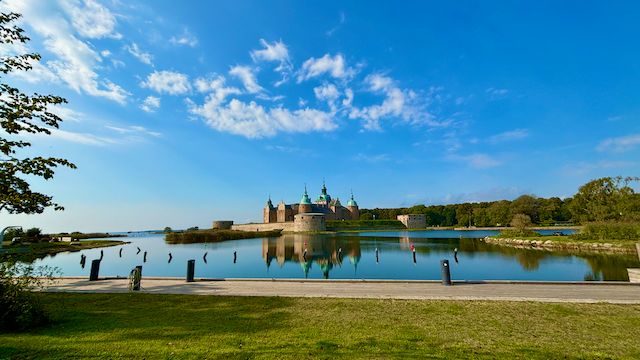On my way to Öland Island last month, I stopped for the night in Kalmar, on the other side of the Kalmar Strait. I meant to head straight back to the airport the next morning, but a nightly wander around the city made me want to explore a bit further. Especially when I spotted Kalmar Castle.
Looking across at the castle, delightfully spooky in the moonlit night, I was reminded of history class in school. You see, Kalmar once played an important role in Scandinavian history. Not just the history of Sweden, but also of Norway and Denmark.
As you can see, it is an imposing structure, this castle. It is a pretty awesome example of Renaissance architecture: the red brick façade, the imposing towers, thick walls, and not least, a moat!
But it didn’t start out like this. It began life in the late 12th century, as a fairly simple fort, a strategic military stronghold to defend against invasions, especially from the Hanseatic League, the medieval seafaring traders we have discussed several times here on the blog. Then, over the years, it evolved into this elaborate castle.
It is easy to imagine all sorts of intriguing events taking place inside the grounds here, isn’t it? Dancing, storytelling, poetry reading, drama, jousting competitions, travelling troubadours, jugglers, acrobats, puppet shows… People drinking ale and wine and eating venison – although as this is on the Baltic sea, fish would frequently have been on the menu. And eel, whale and sea turtles.
The Kalmar Union
But the event I’m thinking about, was the signing of a treaty. And not just any treaty, but the Treaty of Kalmar, which in 1397 united Norway, Sweden and Denmark under a single monarch. The three countries signed the treaty right here, at Kalmar Castle – and the monarch in question was Queen Margrete I of Denmark. The idea was to create one stable political entity, powerful against external threats.
The union consisted of the three kingdoms: Sweden, Denmark, and Norway, as well as Norway’s overseas colonies (Iceland, Greenland, the Faroe Islands, Orkneys, Shetland, and the Hebrides). It was a political union, where each country was a sovereign state, with its own laws and customs. Legally, at least. But the monarch, usually a Dane, dictated domestic and foreign policy. Within the union, there was cooperation, but also conflicts and clashes of national interests (sound familiar?).
In 1534, King Gustav Vasa declared Sweden’s independence after the Swedish War of Liberation. Norway, meanwhile, was stuck with Denmark for a further three centuries. The Black Death (the bubonic plague of the mid-1300s) hit Norway particularly hard. More than half the population was killed, including the elite, those who would have been in a position to preserve and protect the state and oppose the Danish occupation. It took 434 years to get out of that relationship. For centuries, this was known as the 400-year night. Still is, to an extent.
During the Kalmar Union, this castle played a crucial role, serving as a meeting point for discussions and negotiations between the monarchs of the three united kingdoms and their representatives. The castle’s strategic location and fortified structure made it a natural choice for such important events.
PS
What happened to the Norwegian colonies, you ask?
In 1469, another Margrete married King James III of Scotland. Margrete was the only daughter of King Christian I of Denmark, then head of the three kingdoms, and Christian agreed to pay a dowry of 60,000 Rhenish florins, the currency of the day. Gold and silver were valued in Rhenish florins back then. In Fuggerei, the social housing project in Augsburg, rent was 1 Rhenish florin per year, and still is. (Which means residents today pay €0.88/year.)
So Christian owed the Scottish Crown €52.800. Not an insignificant amount in 1469. And Christian didn’t have the money, so he used Shetland and Orkneys as collateral. Later, the Hebrides was included, as well.
As it turned out, Christian never paid his debt, that scoundrel. Four years later, Scotland said ‘enough already!’, and annexed the islands. If I could travel back in time, I like to think I would confront that unwanted king of Norway, and make him pay the dowry.
And it looks like I might have the backing of Shetlanders and Orcadians. Just last year (2023), Orkney Islands Council voted – and not for the first time – on a motion to possibly join Norway.
We were part of the Norse kingdom for much longer than we were part of the United Kingdom. On the street in Orkney people come up and say to me when are we going to pay back the dowry, when are we going back to Norway…
Orkney Islands Council leader, James Stockan
Kalmar Castle – and the Scandinavian Union is a post from Sophie’s World
